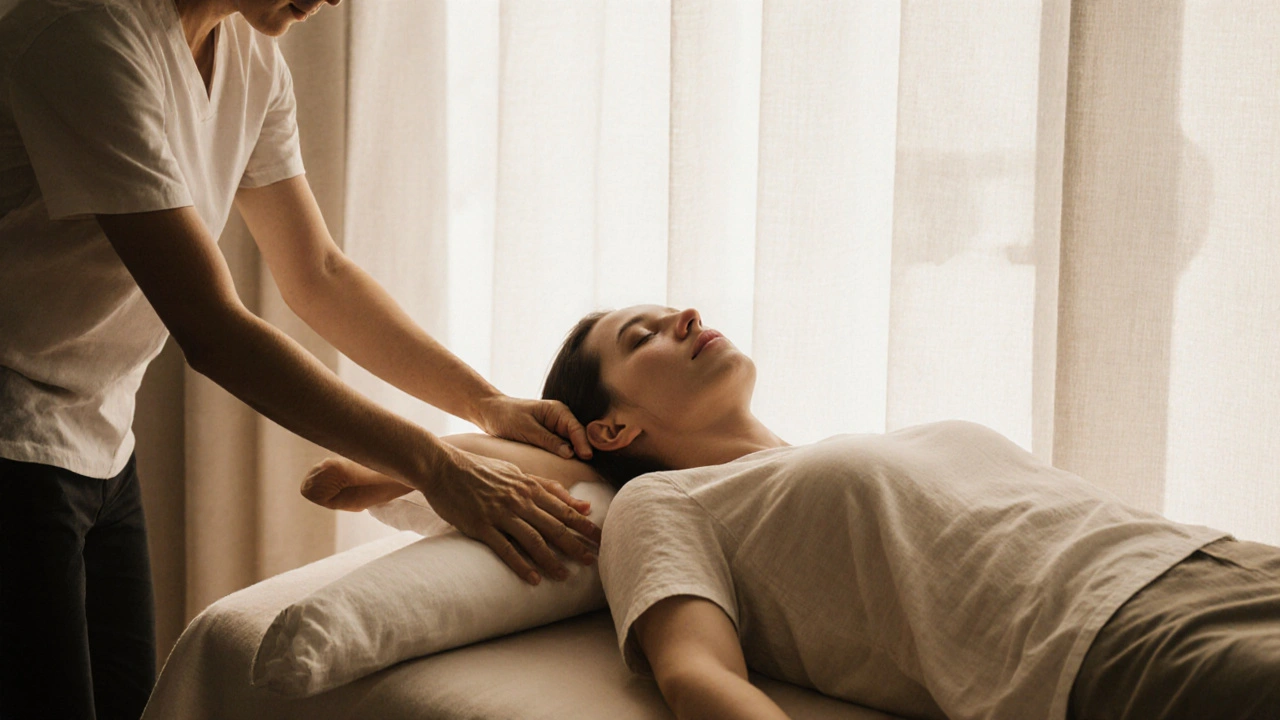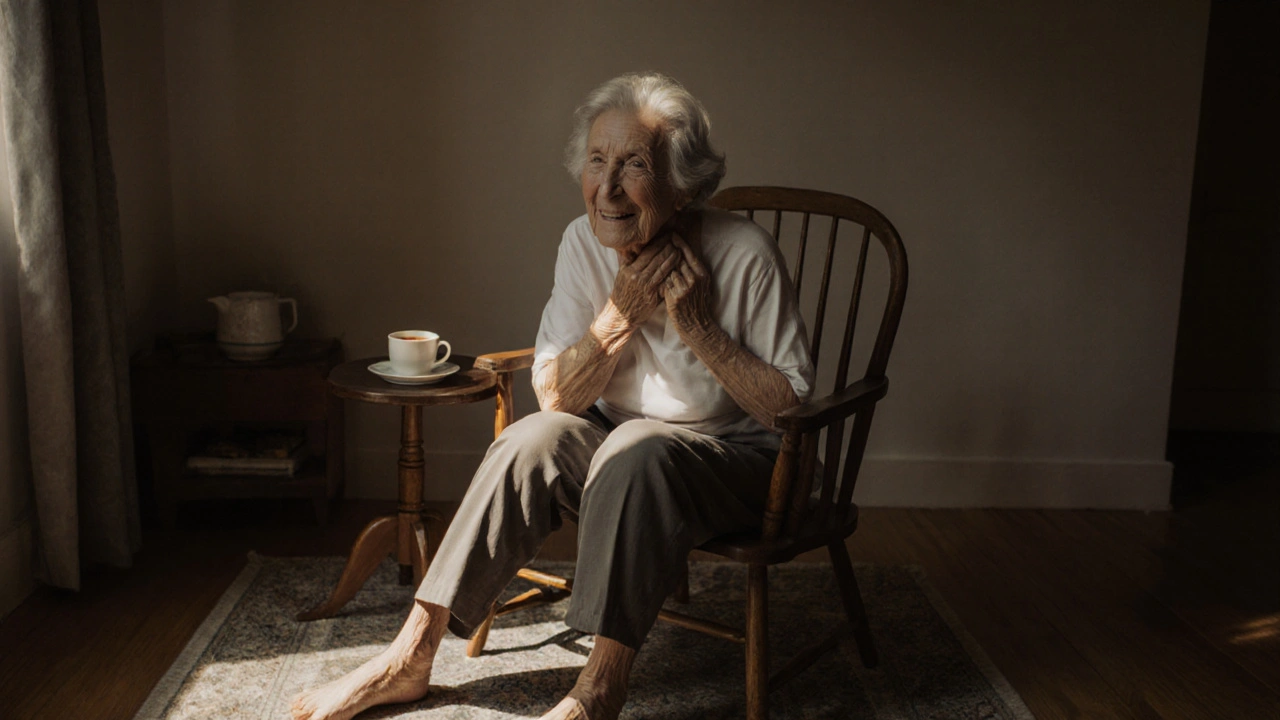Maximizing Your Health with Ortho-Bionomy: A Simple Guide to Gentle Pain Relief
 Nov, 15 2025
Nov, 15 2025
Self-Ortho-Bionomy Position Finder
Select where you're experiencing discomfort:
Step 1: Find Your Position
Move slowly into the position that makes your discomfort feel slightly worse. Don't push - just find the edge of comfort.
Step 2: Discover the Relief Position
Now make the tiniest movement that makes it feel easier. This might be shifting your head slightly or bending your knee a fraction.
Step 3: Hold and Breathe
Stay in this position for the selected duration. Breathe gently. Don't try to fix it - just notice your body's response.
Ortho-Bionomy works through proprioceptive neuromodulation. When your body finds a comfortable position, your nervous system signals to release tension because it no longer perceives danger.
This gentle approach helps your body remember how to relax naturally without force or manipulation. The more you practice, the faster your body recognizes its own comfort zones.
What if you could ease chronic pain, reduce stress, and improve your movement-without pushing, pulling, or forcing your body? That’s the quiet promise of ortho-bionomy. Unlike massage or chiropractic adjustments that rely on pressure or cracking joints, ortho-bionomy works with your body’s own intelligence. It doesn’t tell your muscles what to do. It shows them a better way to relax-naturally.
What Is Ortho-Bionomy?
Ortho-bionomy is a gentle, non-invasive bodywork method developed in the 1970s by British osteopath Dr. Arthur Lincoln Pauls. He noticed that when people were placed in positions of comfort-where their body naturally wanted to rest-their pain often faded on its own. He didn’t fix anything. He just helped the body remember how to undo its own tension.
It’s based on three simple principles: comfort, movement, and feedback. Your body already knows how to heal. Ortho-bionomy just gives it the space to do it. Practitioners use light touch, positioning, and gentle rocking to guide you into postures that feel easy. No pain. No force. Just a quiet shift.
It’s not a new-age trend. It’s grounded in anatomy, neurology, and biomechanics. The nervous system hates pain. When it senses discomfort, it locks muscles, tightens joints, and protects the area-even if the injury is long gone. Ortho-bionomy tricks the nervous system into letting go by offering a safer, more comfortable alternative.
How It Works: The Body’s Self-Correcting Mechanism
Your body is constantly adjusting. When you twist your ankle, your brain says, “Hold still.” Muscles tighten. Joints stiffen. That’s protection. But if the pain doesn’t go away, the body stays stuck in that protective mode. Years later, you might still feel tightness-even if the ankle healed perfectly.
Ortho-bionomy doesn’t try to “fix” the tightness. Instead, it finds the position where your body feels least resistance. Maybe you tilt your head slightly to the left, or bend your knee just a little more. The practitioner doesn’t push. They just wait. And slowly, your muscles begin to soften. Your joints realign. Not because someone moved them-but because your nervous system decided it was safe to let go.
This is called proprioceptive neuromodulation. In plain terms: your brain learns a new way to be. No needles. No drugs. No cracking. Just a quiet conversation between your body and your awareness.
Who Benefits Most?
Ortho-bionomy isn’t for everyone-but it’s perfect for people who’ve tried everything else.
- People with chronic back or neck pain that won’t respond to massage or physio
- Those recovering from surgery or injury who can’t handle deep pressure
- Seniors with arthritis or joint stiffness
- People with fibromyalgia, chronic fatigue, or stress-related tension
- Athletes who want to recover without aggressive manipulation
- Anyone who hates being “adjusted” or feels worse after a chiropractic session
I’ve seen clients come in with pain that’s lasted ten years. One woman, 68, had shoulder pain so bad she couldn’t brush her hair. She’d had injections, physio, acupuncture-nothing stuck. After three ortho-bionomy sessions, she could lift her arm again. Not because her shoulder was “fixed.” But because her nervous system finally stopped guarding it.
What to Expect in a Session
A typical session lasts 60 to 75 minutes. You stay fully clothed. No oils. No undressing. You lie on a table, sit in a chair, or even stand-whatever feels most comfortable.
The practitioner asks you where you feel discomfort. Then they gently guide you into positions that mirror that sensation-but slightly softened. If your neck is stiff to the right, they’ll help you tilt your head just a little more right… until you feel a whisper of ease. Then they hold it. No pushing. No holding you there. Just waiting.
You might feel warmth, tingling, or a sudden sigh. Sometimes nothing happens at all. That’s okay. The work is happening below the surface.
By the end, you’ll likely feel lighter. More relaxed. Not necessarily pain-free-but less afraid of the pain. That’s the first big win.

Self-Ortho-Bionomy: Do It Yourself
You don’t need a practitioner to start feeling better. Ortho-bionomy is designed to be learned and practiced at home.
Here’s how:
- Find a spot where you feel tension-your lower back, your jaw, your shoulders.
- Move slowly into the position that makes it worse. Just a little. Don’t push.
- Now, find the tiniest movement that makes it feel easier. Maybe you roll your shoulder forward half an inch. Or tilt your head left instead of right.
- Stay there. Breathe. Don’t try to fix it. Just let your body explore.
- After 30 seconds to a minute, you’ll feel a subtle shift. The tension softens. That’s your nervous system relaxing.
Do this daily. Even for two minutes. You’ll start noticing your body finds comfort faster. Over time, you’ll need less of it.
Why It’s Different from Massage or Chiropractic
Massage pushes. Chiropractic adjusts. Physiotherapy corrects. Ortho-bionomy invites.
Massage might feel good in the moment, but if your nervous system is still on high alert, the tension comes back. Chiropractic adjustments can help-but if your body doesn’t trust the new position, it snaps back. Ortho-bionomy doesn’t force a change. It helps your body choose it.
Think of it like this: If you’re stuck in traffic, yelling at the car in front of you won’t move it. But if you find a side road-quiet, empty-you just drive through. Ortho-bionomy finds the side road.
Scientific Backing and Growing Recognition
While ortho-bionomy hasn’t been studied as widely as physiotherapy, the principles behind it are solid. Research on proprioception, neuroplasticity, and pain neuroscience supports its approach.
A 2020 study in the Journal of Bodywork and Movement Therapies found that gentle, comfort-based techniques like ortho-bionomy significantly reduced pain and anxiety in patients with chronic low back pain-without any physical manipulation. Another study in 2023 showed improved mobility in older adults after just six sessions, with no adverse effects.
It’s now taught in osteopathic schools in the UK, Canada, and Australia. Practitioners must complete 400+ hours of training. It’s not a side hustle. It’s a respected therapy with a growing evidence base.

Where to Find a Practitioner
Ortho-bionomy isn’t everywhere-but it’s easier to find than you think. In Australia, trained practitioners are listed through the Ortho-Bionomy Association of Australia. In the US, check the Ortho-Bionomy Society of North America. In the UK, the British Ortho-Bionomy Association has a directory.
Look for someone who says they work “with the body’s self-correction.” Avoid anyone who promises quick fixes, uses strong manipulation, or claims to “reset” your spine. That’s not ortho-bionomy.
What It Won’t Do
Ortho-bionomy isn’t magic. It won’t:
- Replace surgery for a torn ligament
- Reverse advanced osteoarthritis
- Cure cancer or autoimmune disease
- Make you feel better after one session if you’ve been in pain for decades
It’s a slow, quiet, sustainable path. It works best when you’re willing to listen-to your body, not to your expectations.
Final Thought: It’s Not About Fixing. It’s About Remembering.
Your body remembers how to heal. It just needs to feel safe enough to try.
Ortho-bionomy doesn’t ask you to change. It asks you to relax. To pause. To notice. And in that stillness, your body does the real work.
If you’ve tried everything and still feel stuck-this might be the quiet path you’ve been looking for. No force. No pain. Just a gentle invitation to feel better.
